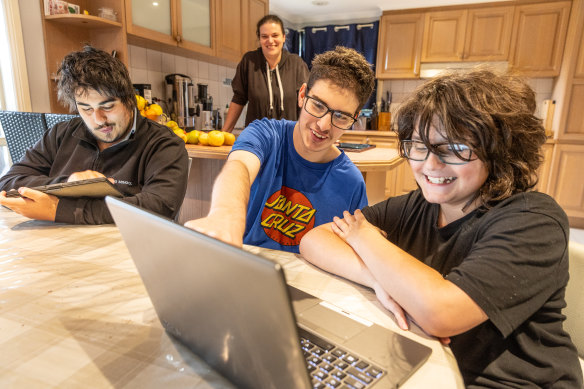For nearly two years, Melbourne mum Chantal Spada and her four boys would use computers at the local library to do their homework.
They would trek there several times a week, but at some points would be there every single day to finish their schoolwork.
“Rain, hail or shine we’d walk down to the library and wait in line, like a lot of other families, just to access the computers,” the Mill Park mum said.

Chantal Spada and her kids, Christian (left), Antonio and Julian had to trek to their library to complete their homework.Credit: Jason South
“We pretty much accepted that there were a lot of other people here for the same reason.”
That was because at home, they only have a single iPad between the four of them. A laptop for each would cost thousands, and that wasn’t in the budget.
“It’s very disheartening ... and knowing the children, they need this technology not just for school, but virtually everything in life now, not being able to provide that for them at the time”
“It’s still a bit of a struggle,” she said.
And they aren’t alone – the Smith Family reports a significant gap between students from lower socio-economic backgrounds or schools compared to their peers at better-resourced schools.
The education charity’s chief executive, Doug Taylor, said some young people had to resort to “extraordinary measures” to get their work done.
“Some are relying on mobile devices and public Wi-Fi to complete schoolwork due to the absence of a reliable laptop or internet connection at home,” the charity head said.
He said one in three students who the charity supported through its Learning for Life program – which provides financial support, guidance and targeted learning programs – weren’t fully equipped with essentials like laptops or a reliable internet connection.
The organisation is also seeing more people reach out for help as the cost-of-living crisis continues.
Having reliable internet and devices was still a challenge for the Spada family, as they still have to deal with the need to purchase up-to-date devices.
“I guess the technology changes so quickly, the devices need to be able to accommodate what the schools are doing so the kids can keep up with their work,” Chantal Spada explained.
It was also a challenge navigating school systems on certain mobile phones, and being able to access an online portal.
“You have to rely on your children being the messengers, and I tell you what, when kids are aware of the sort of lengths they need to go to just to get an excursion form signed, it has a pretty significant effect on their education,” she said.
“They limit themselves, and I think that’s a real problem for young people experiencing barriers with digital access.”
She was also concerned about digital literacy, as more jobs relied on technology than in the past.
Recent Australian, Curriculum Assessment and Reporting analysis of the national assessment program for information and communications literacy assessment found students from lower-income households scored far worse than those from higher socio-economic backgrounds. Boys from years 6 to 10 were also more likely to have lower levels of ICT literacy than girls.
The Smith Family also said that while 1.2 million children and young people in Australia were still experiencing poverty, it prevented their access to digital connection.
Swinburne academic Melinda Davis, who also taught in schools for nearly 30 years, said equitable and reliable access to the internet should be a priority for young people.
“A child’s economic status should not be a prohibitive factor in the pursuit of an education; nor should quality of life be inherently linked to the quality of a child’s internet connection,” she said.
She said fostering digital literacy was more important with the rise of AI.
“Being able to both creatively use and critically evaluate the AI algorithm will position young people in future job markets, which in turn can greatly impact on their quality of life.”
A report from Work Ventures, a charity that wants to expand access to technology and expand digital literacy, and KMPG surveyed more than 130 students from six schools around the country and found 84 per cent of students with inadequate access struggled to finish class work and assignments.
The organisation found it was representative of two in five year 6 students, and a quarter of year 10 students who did not have access to a computer outside of school.
Get the day’s breaking news, entertainment ideas and a long read to enjoy. Sign up to receive our Evening Edition newsletter here.